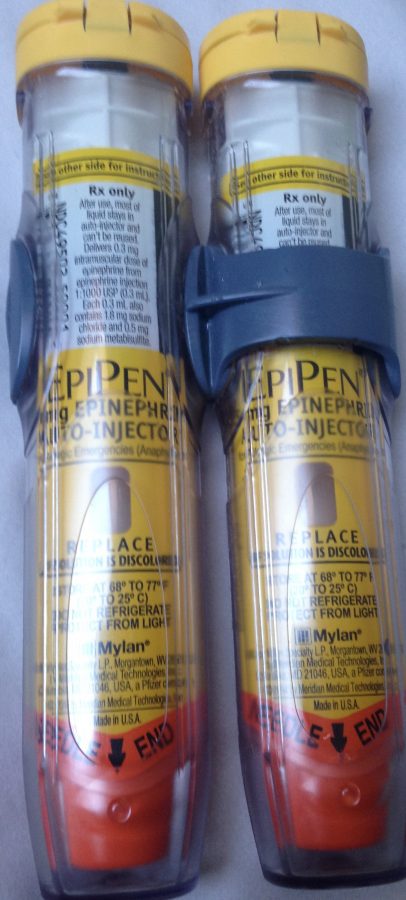EpiPen price creates sticker shock
September 13, 2016
EpiPen prices have recently skyrocketed, and people with life-threatening allergies are feeling the effects. This could be detrimental for the students at Big Spring who depend upon these medicinal injections to treat their own life threatening allergies.
EpiPens, as defined by Dictionary.com, are “the brand name of a medical injecting device that delivers a dose of epinephrine, used to treat severe allergic reactions, including anaphylaxis.” They are sold in set of two needles. When a person first has a severe allergic reaction, the injection is administered into their thigh. After twenty minutes, the other injection is also administered. Doctors recommend that people who use EpiPens buy three sets of these life-saving injections. One should be kept at home, one at work or school, and the last one to be taken wherever the patient may go and be exposed to their allergen.
It comes as no surprise to many that the cost of EpiPens has risen gradually over the years, but the price has now recently risen by an alarming “400%”. In fact, USA Today cites that the price has gone up to “$57 in 2007 to about $500 today.” While price-spiking of medicine is not “prohibited by antitrust laws”, this is causing severe problems for people who depend upon this medicine. To buy the recommended amount of EpiPens for people with severe allergic reactions (three sets of two injections), the cost comes to be about $1800. USA today source Sen. Chuck Grassley said, “I am concerned that the substantial price increase could limit access to a much-needed medication,”. Most people in the USA are covered by some form of health insurance. When people who use EpiPens have health insurance with a high deductible, they end up having to pay more for the $600 drug out of pocket. For parents who don’t work high paying jobs, are unemployed, or are not covered by health insurance, spending this kind of money does not come very easily.
Sarah Enck, community member and mother of three, has a nine year old daughter who uses EpiPens. When Enck’s daughter, Maslynn Enck, eats certain tree nuts, cashews, etc., she gets severe stomach pains, her face swells, and certain portions of her face even turn black and blue. Enck and her daughter are some of the personally lucky ones who have this newly-risen cost mostly covered by health insurance. “This medicine is life-saving and should be given to anyone regardless of financial capabilities,” said Enck in relation to the families who may have to foot the bill themselves. While Enck’s daughter is able to use Benadryl to initially slow the effects of her allergic reaction, for many, EpiPens are the only option.
While this problem may not appear to be hitting directly home, 12 out of the 873 students at Big Spring High School use EpiPens according to Nurse Julie Eddy. “Epinephrine, or what is the medication inside the EpiPen, is the only thing out there…and it’s life-saving for many people…It’s vital for students, parents, and the whole world. In relation to the newly risen cost, Eddy said, “$1800, coming out of a personal pocket, is not easy to find in anyone’s life…That’s a month’s or several month’s worth or groceries.” Connor Oburn, a tenth grader at Big Spring, is allergic to bees and uses an EpiPen. Though Oburn’s allergen does not cause any life or death symptoms, he said, ” You have to pay more. If you have an allergy that you really need an EpiPen for, it kinda sucks,” in relation to the price spike.
Currently, there is only one thing helping to alleviate the cost of EpiPens. EpiPens manufacturers are offering a three hundred dollar voucher, essentially a gift certificate, for all people who are not covered by certain health insurances. While this may help with some of the cost, the price for the recommended amount of EpiPens is still over an unjust $1000.
